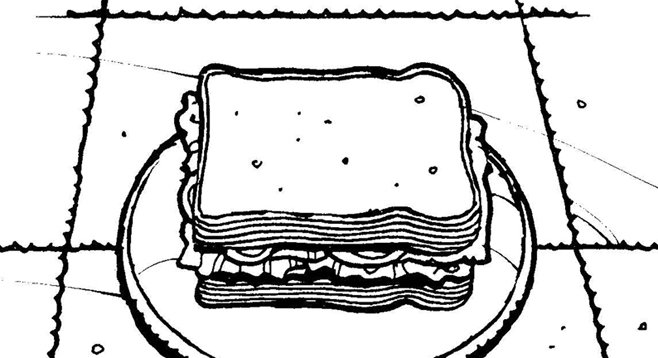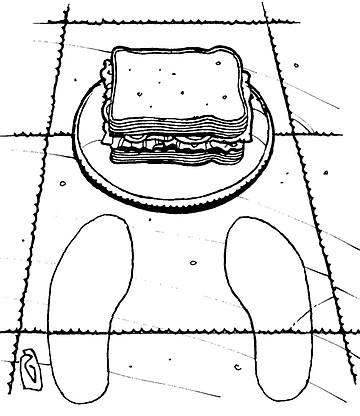 Facebook
Facebook
 X
X
 Instagram
Instagram
 TikTok
TikTok
 Youtube
Youtube

Heymatt:
While eating at Denny’s nearly 20 years ago, I met a nice, “young” woman who grew up during the Great Depression and claimed to have been one of the first females to graduate from UCLA. Her most memorable story was of people painting white shoes (or the outlines of white shoes) on the sidewalk outside their homes to signify where anyone down on his luck could ask for a free meal. If this is true, I plan on doing it to see what happens — maybe with a picture of a sandwich & a soda.
— Dirty Doug, via email

We’ve combed through the archives, looking through newspapers as far back as the 19th Century, and we can neither confirm nor deny this story. I’ve sent the elves deeper into the musty stacks than they have gone in a long time, and all to no avail. I can’t find so much as a single mention of this particular sigil. Zip. Nada. I did unearth a piecemeal cryptographic history of secret signs and symbols from all over the world and it might hold some clues. I think it’s most likely that the “white shoes” are somehow related to the system of glyphs that hobos used during the ’20s and ’30s, when ’bos where on the rise. Hobos had signs for everything, from basic directions (“turn left here”) to warnings (“cops jail hobos in this town,” signified by a stylized handcuff) and tips, like a pictogram of a kitty cat that meant “nice old lady lives here.” One of the most important signs a hobo could look for would indicate that a house was home to hospitable people and that an enterprising vagrant could work for a hot meal and a place to sleep. The exact form of that sign varied based on locale and hobo style, but the most common sign was a circle inscribed with a cross: O with a + inside. That particular symbol dates all the way back to the Bronze Age and pre-Christian Norse myth, but it’s still in use today by the few hobos who still ride the rails and look for work where they can get it. You could try putting one of those up to demarcate your house, but don’t be surprised if ’bos come knocking! If that doesn’t work, just dress like a cow on July 12th next year and go to Chick-fil-A. They’ll give you free food. I’m serious. It’s “Cow Appreciation Day!”
Hello Matthew:
Are people renewing their marijuana cards? My old doctor has removed all the links from his website and the website itself just displays a few articles on the topic.
— Sandy
Some doctors are still giving out recommendations to patients that their health would be better served through the use of medical marijuana. As politicized and divisive as the debate surrounding medical marijuana has become, it’s likely that your old doctor has decided to tone it down a little bit in terms of advertising his involvement with medical cannabis. Perhaps he has stopped giving out recommendations altogether, but I would bet it’s become more of a doctor/patient issue and something he doesn’t just throw up on the website. Other clinics are choosing to keep on keeping on with their marijuana policies — just open the back of the Reader or any other paper and have a look around.
Hi Matthew:
I was watching my son bang his Hot Wheels together and it reminded me of a question from my childhood: how come they don’t show crash damage like our adult cars do? I know the scale materials are way stronger at the teeny-tiny HotWheels level, but is it possible to recreate a Hot Wheels–sized car that would show the same kind of damage when crashed into another at scale speed? Maybe this could be an untapped market for showing children the dangers of hazardous driving or a way to persuade them to treat their toys more gently? Honestly, I just want to crash cars together and revel in the carnage!
— Chris, Oceanside
Toy cars lack sufficient mass to generate any significant force. Newton says that force = mass x acceleration, so without any substance they don’t crash very hard. Also, most Hot Wheels cars are solid. Real cars have lots of empty space for materials to fold, buckle, and compress into. In order to create a crashable model, you would have to make it out of wafer-thin materials and replicate the internal structure of the real car. Hot Wheels cars are built to a 1:64 scale, so a 21-gauge steel panel (standard for the skin of modern automobiles) scales all the way down to 0.0005 inches thick, which is thinner than aluminum foil. Built to a more workable scale, maybe 1:32, the metal would be rigid enough to give the car some structure, but it would have razor-sharp edges after crashing and kids might end up being rushed to the emergency room with lacerated fingers...although you might be right about that being a pointed lesson in the dangers of reckless driving.


Heymatt:
While eating at Denny’s nearly 20 years ago, I met a nice, “young” woman who grew up during the Great Depression and claimed to have been one of the first females to graduate from UCLA. Her most memorable story was of people painting white shoes (or the outlines of white shoes) on the sidewalk outside their homes to signify where anyone down on his luck could ask for a free meal. If this is true, I plan on doing it to see what happens — maybe with a picture of a sandwich & a soda.
— Dirty Doug, via email

We’ve combed through the archives, looking through newspapers as far back as the 19th Century, and we can neither confirm nor deny this story. I’ve sent the elves deeper into the musty stacks than they have gone in a long time, and all to no avail. I can’t find so much as a single mention of this particular sigil. Zip. Nada. I did unearth a piecemeal cryptographic history of secret signs and symbols from all over the world and it might hold some clues. I think it’s most likely that the “white shoes” are somehow related to the system of glyphs that hobos used during the ’20s and ’30s, when ’bos where on the rise. Hobos had signs for everything, from basic directions (“turn left here”) to warnings (“cops jail hobos in this town,” signified by a stylized handcuff) and tips, like a pictogram of a kitty cat that meant “nice old lady lives here.” One of the most important signs a hobo could look for would indicate that a house was home to hospitable people and that an enterprising vagrant could work for a hot meal and a place to sleep. The exact form of that sign varied based on locale and hobo style, but the most common sign was a circle inscribed with a cross: O with a + inside. That particular symbol dates all the way back to the Bronze Age and pre-Christian Norse myth, but it’s still in use today by the few hobos who still ride the rails and look for work where they can get it. You could try putting one of those up to demarcate your house, but don’t be surprised if ’bos come knocking! If that doesn’t work, just dress like a cow on July 12th next year and go to Chick-fil-A. They’ll give you free food. I’m serious. It’s “Cow Appreciation Day!”
Hello Matthew:
Are people renewing their marijuana cards? My old doctor has removed all the links from his website and the website itself just displays a few articles on the topic.
— Sandy
Some doctors are still giving out recommendations to patients that their health would be better served through the use of medical marijuana. As politicized and divisive as the debate surrounding medical marijuana has become, it’s likely that your old doctor has decided to tone it down a little bit in terms of advertising his involvement with medical cannabis. Perhaps he has stopped giving out recommendations altogether, but I would bet it’s become more of a doctor/patient issue and something he doesn’t just throw up on the website. Other clinics are choosing to keep on keeping on with their marijuana policies — just open the back of the Reader or any other paper and have a look around.
Hi Matthew:
I was watching my son bang his Hot Wheels together and it reminded me of a question from my childhood: how come they don’t show crash damage like our adult cars do? I know the scale materials are way stronger at the teeny-tiny HotWheels level, but is it possible to recreate a Hot Wheels–sized car that would show the same kind of damage when crashed into another at scale speed? Maybe this could be an untapped market for showing children the dangers of hazardous driving or a way to persuade them to treat their toys more gently? Honestly, I just want to crash cars together and revel in the carnage!
— Chris, Oceanside
Toy cars lack sufficient mass to generate any significant force. Newton says that force = mass x acceleration, so without any substance they don’t crash very hard. Also, most Hot Wheels cars are solid. Real cars have lots of empty space for materials to fold, buckle, and compress into. In order to create a crashable model, you would have to make it out of wafer-thin materials and replicate the internal structure of the real car. Hot Wheels cars are built to a 1:64 scale, so a 21-gauge steel panel (standard for the skin of modern automobiles) scales all the way down to 0.0005 inches thick, which is thinner than aluminum foil. Built to a more workable scale, maybe 1:32, the metal would be rigid enough to give the car some structure, but it would have razor-sharp edges after crashing and kids might end up being rushed to the emergency room with lacerated fingers...although you might be right about that being a pointed lesson in the dangers of reckless driving.
Comments